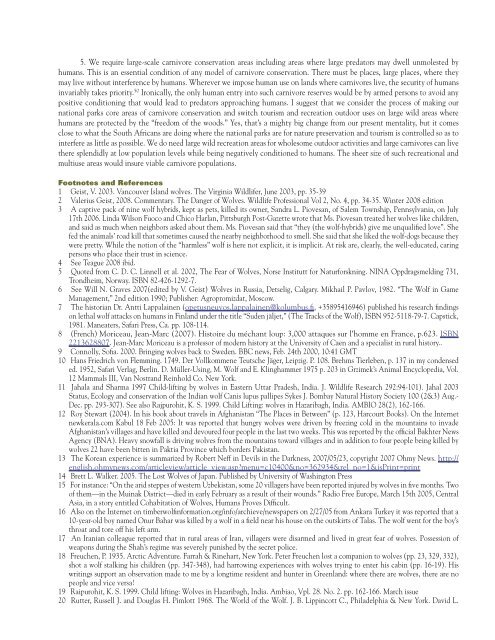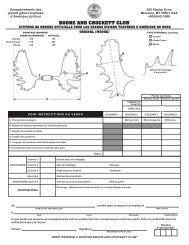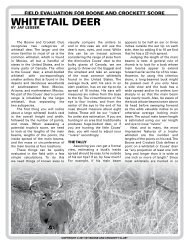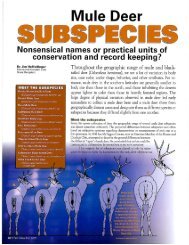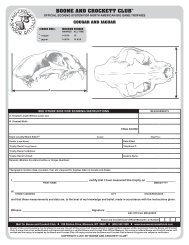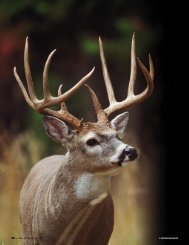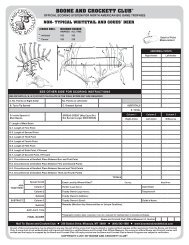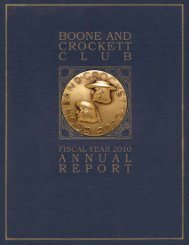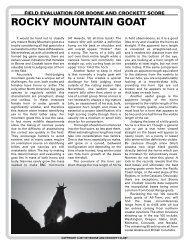WOLF ESSAY - Boone and Crockett Club
WOLF ESSAY - Boone and Crockett Club
WOLF ESSAY - Boone and Crockett Club
- No tags were found...
Create successful ePaper yourself
Turn your PDF publications into a flip-book with our unique Google optimized e-Paper software.
5. We require large-scale carnivore conservation areas including areas where large predators may dwell unmolested byhumans. This is an essential condition of any model of carnivore conservation. There must be places, large places, where theymay live without interference by humans. Wherever we impose human use on l<strong>and</strong>s where carnivores live, the security of humansinvariably takes priority. 50 Ironically, the only human entry into such carnivore reserves would be by armed persons to avoid anypositive conditioning that would lead to predators approaching humans. I suggest that we consider the process of making ournational parks core areas of carnivore conservation <strong>and</strong> switch tourism <strong>and</strong> recreation outdoor uses on large wild areas wherehumans are protected by the “freedom of the woods.” Yes, that’s a mighty big change from our present mentality, but it comesclose to what the South Africans are doing where the national parks are for nature preservation <strong>and</strong> tourism is controlled so as tointerfere as little as possible. We do need large wild recreation areas for wholesome outdoor activities <strong>and</strong> large carnivores can livethere splendidly at low population levels while being negatively conditioned to humans. The sheer size of such recreational <strong>and</strong>multiuse areas would insure viable carnivore populations.Footnotes <strong>and</strong> References1 Geist, V. 2003. Vancouver Isl<strong>and</strong> wolves. The Virginia Wildlifer, June 2003, pp. 35-392 Valerius Geist, 2008. Commentary. The Danger of Wolves. Wildlife Professional Vol 2, No. 4, pp. 34-35. Winter 2008 edition3 A captive pack of nine wolf hybrids, kept as pets, killed its owner, S<strong>and</strong>ra L. Piovesan, of Salem Township, Pennsylvania, on July17th 2006. Linda Wilson Fuoco <strong>and</strong> Chico Harlan, Pittsburgh Post-Gazette wrote that Ms. Piovesan treated her wolves like children,<strong>and</strong> said as much when neighbors asked about them. Ms. Piovesan said that “they (the wolf-hybrids) give me unqualified love”. Shefed the animals’ road kill that sometimes caused the nearby neighborhood to smell. She said that she liked the wolf-dogs because theywere pretty. While the notion of the “harmless” wolf is here not explicit, it is implicit. At risk are, clearly, the well-educated, caringpersons who place their trust in science.4 See Teague 2008 ibid.5 Quoted from C. D. C. Linnell et al. 2002, The Fear of Wolves, Norse Institutt for Naturforskning. NINA Oppdragsmelding 731,Trondheim, Norway. ISBN 82-426-1292-7.6 See Will N. Graves 2007(edited by V. Geist) Wolves in Russia, Detselig, Calgary. Mikhail P. Pavlov, 1982. “The Wolf in GameManagement,” 2nd edition 1990; Publisher: Agropromizdat, Moscow.7 The historian Dr. Antti Lappalainen (opetusneuvos.lappalainen@kolumbus.fi, +35895416946) published his research findingson lethal wolf attacks on humans in Finl<strong>and</strong> under the title “Suden jäljet,” (The Tracks of the Wolf), ISBN 952-5118-79-7. Capstick,1981. Maneaters, Safari Press, Ca. pp. 108-114.8 (French) Moriceau, Jean-Marc (2007). Histoire du méchant loup: 3,000 attaques sur l’homme en France, p.623. ISBN2213628807. Jean-Marc Moriceau is a professor of modern history at the University of Caen <strong>and</strong> a specialist in rural history..9 Connolly, Sofia. 2000. Bringing wolves back to Sweden. BBC news, Feb. 24th 2000, 10:41 GMT10 Hans Friedrich von Flemming. 1749. Der Vollkommene Teutsche Jäger, Leipzig. P. 108. Brehms Tierleben, p. 137 in my condenseded. 1952, Safari Verlag, Berlin. D. Müller-Using, M. Wolf <strong>and</strong> E. Klinghammer 1975 p. 203 in Grzimek’s Animal Encyclopedia, Vol.12 Mammals III, Van Nostr<strong>and</strong> Reinhold Co. New York.11 Jahala <strong>and</strong> Sharma 1997 Child-lifting by wolves in Eastern Uttar Pradesh, India. J. Wildlife Research 292:94-101). Jahal 2003Status, Ecology <strong>and</strong> conservation of the Indian wolf Canis lupus pallipes Sykes J. Bombay Natural History Society 100 (2&3) Aug.-Dec. pp. 293-307). See also Rajpurohit, K. S. 1999. Child Lifting: wolves in Hazaribagh, India. AMBIO 28(2), 162-166.12 Roy Stewart (2004). In his book about travels in Afghanistan “The Places in Between” (p. 123, Harcourt Books). On the Internetnewkerala.com Kabul 18 Feb 2005: It was reported that hungry wolves were driven by freezing cold in the mountains to invadeAfghanistan’s villages <strong>and</strong> have killed <strong>and</strong> devoured four people in the last two weeks. This was reported by the official Bakhter NewsAgency (BNA). Heavy snowfall is driving wolves from the mountains toward villages <strong>and</strong> in addition to four people being killed bywolves 22 have been bitten in Paktia Province which borders Pakistan.13 The Korean experience is summarized by Robert Neff in Devils in the Darkness, 2007/05/23, copyright 2007 Ohmy News. http://english.ohmynews.com/articleview/article_view.asp?menu=c10400&no=362934&rel_no=1&isPrint=print14 Brett L. Walker. 2005. The Lost Wolves of Japan. Published by University of Washington Press15 For instance: “On the arid steppes of western Uzbekistan, some 20 villagers have been reported injured by wolves in five months. Twoof them—in the Muinak District—died in early February as a result of their wounds.” Radio Free Europe, March 15th 2005, CentralAsia, in a story entitled Cohabitation of Wolves, Humans Proves Difficult.16 Also on the Internet on timberwolfinformation.org/info/archieve/newspapers on 2/27/05 from Ankara Turkey it was reported that a10-year-old boy named Onur Bahar was killed by a wolf in a field near his house on the outskirts of Talas. The wolf went for the boy’sthroat <strong>and</strong> tore off his left arm.17 An Iranian colleague reported that in rural areas of Iran, villagers were disarmed <strong>and</strong> lived in great fear of wolves. Possession ofweapons during the Shah’s regime was severely punished by the secret police.18 Freuchen, P. 1935. Arctic Adventure. Farrah & Rinehart, New York. Peter Freuchen lost a companion to wolves (pp. 23, 329, 332),shot a wolf stalking his children (pp. 347-348), had harrowing experiences with wolves trying to enter his cabin (pp. 16-19). Hiswritings support an observation made to me by a longtime resident <strong>and</strong> hunter in Greenl<strong>and</strong>: where there are wolves, there are nopeople <strong>and</strong> vice versa!19 Raipurohit, K. S. 1999. Child lifting: Wolves in Hazaribagh, India. Ambiao, Vpl. 28. No. 2. pp. 162-166. March issue20 Rutter, Russell J. <strong>and</strong> Douglas H. Pimlott 1968. The World of the Wolf. J. B. Lippincott C., Philadelphia & New York. David L.


